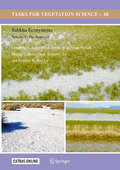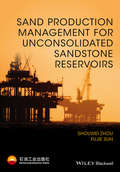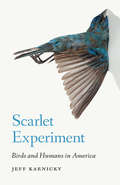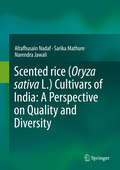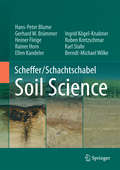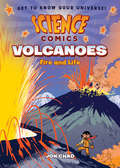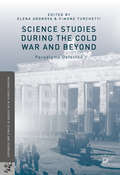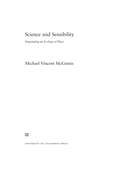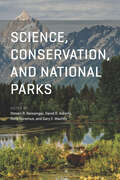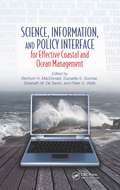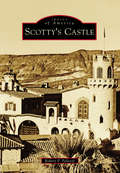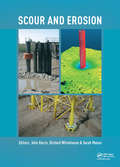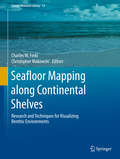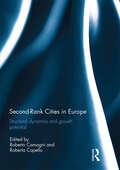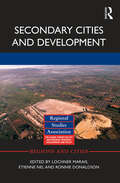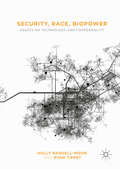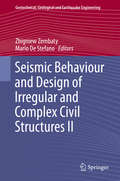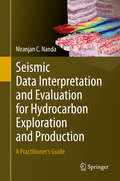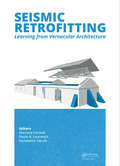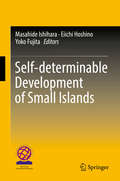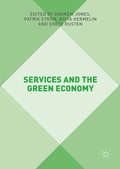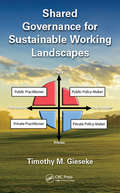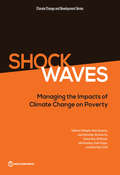- Table View
- List View
Sabkha Ecosystems Volume V: The Americas
by Siegmar-W. Breckle Miguel Clüsener-Godt M. Ajmal Ajmal Khan Benno Boër Münir Ȫzturk Bilquees GulThis book is a part of the Sabkha Ecosystems series which was designed to provide information on sabkha ecosystems of different regions and to add to the collective knowledge available about saline ecosystems. The comprehensive coverage assists the reader gaining a thorough understanding of sabkha geology, hydrology, geomorphology, zoology, botany, ecology and ecosystem functioning, as well as sabkha conservation, utilization and development. Volume I focused on The Arabian Peninsula and Adjacent Countries, volume II was based on describing saline ecosystems of West and Central Asia , volume III referred to Africa and Southern Europe, while volume IV focused on Cash Crop Halophyte and Biodiversity Conservation. The present volume V focuses on Americans.
Sand Production Management for Unconsolidated Sandstone Reservoirs
by Shouwei Zhou Fujie SunThis book investigates sand production problems in the development of unconsolidated sand reservoirs and suggests novel technical solutions and improvements to sand management issues. This book is divided into six chapters: (1) geologic characteristics of unconsolidated sand heavy oil reservoirs and concept of sand management technology; (2) sand production mechanisms and its effect on reservoir petrophysical quality; (3) sand production quantity prediction and well productivity evaluation methods, especially for fluid-solid coupling prediction model; (4) completion technology for sand management; (5) sand flow in well bore and surface processing; (6) the application of sand management technology in China’s Bohai heavy oil field. Readership: Petroleum reservoir engineers and production managers worldwide.
Scarlet Experiment: Birds and Humans in America
by Jeff KarnickyEmily Dickinson’s poem “Split the Lark” refers to the “scarlet experiment” by which scientists destroy a bird in order to learn more about it. Indeed, humans have killed hundreds of millions of birds—for science, fashion, curiosity, and myriad other reasons. In the United States alone, seven species of birds are now extinct and another ninety-three are endangered. Conversely, the U.S. conservation movement has made bird-watching more popular than ever, saving countless bird populations; and while the history of actual physical human interaction with birds is complicated, our long aesthetic and scientific interest in them is undeniable. Since the beginning of the modern conservation movement in the mid-nineteenth century, human understanding of and interaction with birds has changed profoundly. In Scarlet Experiment, Jeff Karnicky traces the ways in which birds have historically been seen as beautiful creatures worthy of protection and study and yet subject to experiments—scientific, literary, and governmental—that have irrevocably altered their relationship with humans. This examination of the management of bird life in America from the nineteenth century to today, which focuses on six bird species, finds that renderings of birds by such authors as Henry David Thoreau, Emily Dickinson, Don DeLillo, and Christopher Cokinos, have also influenced public perceptions and actions. Scarlet Experiment speculates about the effects our decisions will have on the future of North American bird ecology.
Scented rice (Oryza sativa L.) Cultivars of India: A Perspective on Quality and Diversity
by Altafhusain Nadaf Sarika Mathure Narendra JawaliThis book represents an original research contribution in the area of aroma volatile biochemistry and the molecular analysis of basmati and non-basmati rice cultivars of India. It demonstrates the utility of headspace-solid phase micro extraction (HS-SPME) coupled with the gas chromatography-flame ionization detection (GC-FID) method, an approach that can help to understand not only the different volatiles contributing to pleasant aroma but also the volatile profile that generates the characteristic cultivar-specific aroma. In addition, the book provides detailed information on diversity, grain morphology, physico-chemical and cooking quality assessment, genetic diversity assessment and marker validation for important quality parameters. As such, it offers a valuable ready reference for agriculture scientists, biochemists, researchers and students involved in quality parameters of rice at the regional and global level.
Scheffer/SchachtschabelSoil Science
by Karl Stahr Hans-Peter Blume Gerhard W. Brümmer Heiner Fleige Rainer Horn Ellen Kandeler Ingrid Kögel-Knabner Ruben Kretzschmar B. Michael WilkeThe soils are fundamental to our existence, delivering water and nutrients to plants, that feed us. But they are in many ways in danger and their conservation is therefore a most important focus for science, governments and society as a whole. A team of world recognised researchers have prepared this first English edition based on the 16th European edition. * The precursors and the processes of soil development * The physical, biological and chemical properties of soils * Nutrients and Pollutants * The various soil classifications with the main focus on the World Reference Base for Soil Resources (WRB) * The most important soils and soil landscapes of the world * Soil Evaluation Techniques * Basic Principles of Soil Conservation Whoever works with soils needs this book.
Science Comics: Fire and Life (Science Comics)
by Jon ChadGet ready to explore the depths of the ocean, the farthest reaches of space, and everything in between! Volcanic eruptions, vampire bats, feathered velociraptors, and more await you in SCIENCE COMICS. In a not-so-distant future our world is as cold as a frozen burrito. But can humanity save itself by harnessing a power that dwells inside the Earth? Explode into the world of geology in Volcanoes: Fire and Life! A lot of magic happens under the Earth's crust. Thanks to magma vents, shifting continental plates, and volcanic eruptions, we know that our planet is alive and in motion. Alongside Aurora, a young explorer, you'll learn that volcanoes are just one of the massively powerful forces at work on our planet. From catastrophic destruction to the creation of new land masses, volcanoes have made their mark on our amazing Earth.
Science Studies during the Cold War and Beyond
by Simone Turchetti Elena AronovaThis book recounts how during the Cold War the study of science moved to the centre of academic through the creation of the new discipline of science studies. In this way the volume charts the importance of these studies for the trajectory of Cold War nations through the elaboration of new national science policies and the transnational dialogue, even across the Iron Curtain, between key scholars involved in shaping their trajectory. By examining how a new group of intellectuals was mobilized by state administrators to convincingly set up a discipline deemed to have major repercussions on the advancement of science in developed and undeveloped nations. Secondly, by putting the study of science at the centre of the dialogue (as well as the confrontation) between nations and Cold War blocs. The volume thus shows how an often considered arcane field of enquiring had in fact major implications for the understanding and fostering of Cold War science.
Science and Sensibility: Negotiating an Ecology of Place
by Michael Vincent McginnisIf humans are to understand and discover ways of addressing complex social and ecological problems, we first need to find intimacy with our particular places and communities. Cultivating a relationship to place often includes a negotiating process that involves both science and sensibility. While science is one key part of an adaptive and resilient society, the cultivation of a renewed sense of place and community is essential as well. Science and Sensibility argues for the need for ecology to engage with philosophical values and economic motivations in a political process of negotiation, with the goal of shaping humans' treatment of the natural world. Michael Vincent McGinnis aims to reframe ecology so it might have greater "trans-scientific" awareness of the roles and interactions among multiple stakeholders in socioecological systems, and he also maintains that deep ecological knowledge of specific places will be crucial to supporting a sustainable society. He uses numerous specific case studies from watershed, coastal, and marine habitats to illustrate how place-based ecological negotiation can occur, and how reframing our negotiation process can influence conservation, restoration, and environmental policy in effective ways.
Science, Conservation, and National Parks
by Gary E. Machlis David D. Ackerly Holly Doremus Steven R. BeissingerAs the US National Park Service marks its centennial in 2016, parks and protected areas worldwide are under increasing threat from a variety of factors, including storms and fires of greater severity, plant and animal extinctions, the changing attitudes of a public that has become more urbanized, and the political pressures of narrow special interest groups. In the face of such rapid environmental and cultural changes, Science, Conservation, and National Parks gathers a group of renowned scholars—including Edward O. Wilson, Jane Lubchenco, Thomas Dietz, and Monica Turner, among many others—who seek to address these problems and, in so doing, to secure a future for protected areas that will push forward the frontiers of biological, physical, and social science in and for parks. Examining the major challenges of parks and protected areas throughout the world, contributors provide answers to a number of key conservation questions, such as: How should stewardship address climate change, urban encroachment and pollution, and invasive species? How can society, especially youth, become more engaged with nature and parks, and are there models to guide interactions between parks and their neighbors? What are appropriate conservation objectives for parks in the Anthropocene? Charting a course for the parks of the next century, Science, Conservation, and National Parks is certain not only to catalyze the continued evolution of US park conservation policy, but also to be an inspiration for parks, conservation, and management worldwide.
Science, Information, and Policy Interface for Effective Coastal and Ocean Management
by Bertrum H. MacDonaldThis book provides a timely analysis of the role that information-particularly scientific information-plays in the policy-making and decision-making processes in coastal and ocean management. It includes contributions from global experts in marine environmental science, marine policy, fisheries, public policy and administration, resource management
Scotty's Castle
by Robert P. PalazzoScotty's Castle is a study in contrasts, much like its setting in Death Valley. While the castle is known worldwide and has been visited by hundreds of thousands of tourists, many myths persist. It is not a castle, nor was it owned by Walter E. Scott, known as "Death Valley Scotty." But the Spanish-style hacienda, also known as Death Valley Ranch, has always been linked to Scott. This book explores the fascinating history of Death Valley Scotty, Albert and Bessie Johnson (the true owners and builders of the castle), and the castle itself from construction to private living quarters to a tourist facility owned and operated by the National Park Service.
Scour and Erosion: Proceedings of the 8th International Conference on Scour and Erosion (Oxford, UK, 12-15 September 2016)
by John Harris, Richard Whitehouse & Sarah MoxonScour and Erosion includes four keynote lectures from world leading researchers cutting across the themes of scour and erosion, together with 132 peer-reviewed papers from 34 countries, covering the principal themes of: - internal erosion- sediment transport- grain scale to continuum scale- advanced numerical modelling of scour and erosion- terrestrial scour and erosion- river and estuarine erosion including scour around structures, and- management of scour/erosion and sediment, including hazard management and sedimentation in dams and reservoirs. Scour and Erosion is ideal for researchers and industry working at the forefront of scour and erosion, and has applications in both the freshwater and marine environments.
Seafloor Mapping along Continental Shelves
by Charles W. Finkl Christopher MakowskiThis university-level reference work covers a range of remote sensing techniques that are useful for mapping and visualizing benthic environments on continental shelves. Chapters focus on overviews of the history and future of seafloor mapping techniques, cartographical visualisation and communication of seafloor mapping, and practical applications of new technologies. Seabed mapping is referenced by high-resolution seismic methods, sidescan sonar, multibeam bathymetry, satellite imagery, LiDAR, acoustic backscatter techniques, and soundscape ecology monitoring, use of autonomous underwater vehicles, among other methods. The wide breadth of subjects in this volume provides diversified coverage of seafloor imaging. This collection of modern seafloor mapping techniques summarizes the state of the art methods for mapping continental shelves.
Seahorses: A Life-Size Guide to Every Species
by Sara A. LourieAbsolutely captivating creatures, seahorses seem like a product of myth and imagination rather than of nature. They are small, elusive, and are named for their heads, which are shaped like miniature ponies with tiny snouts. They swim slowly upright by rapidly fanning their delicate dorsal fin, coil their tails to anchor themselves in a drift, and spend days in a dancing courtship. Afterward, it is the male who carries the female's eggs in his pouch and hatches the young. Seahorses are found worldwide, and they are highly sensitive to environmental destruction and disturbance, making them the flagship species for shallow-water habitat conservation. They are as ecologically important as they are beautiful. Seahorses celebrates the remarkable variety of seahorse species as well as their exquisiteness. 57 species, including seadragons and pipefish, are presented in lush, life-size photographs alongside descriptive drawings, and each entry includes detailed and up-to-date information on natural history and conservation. Sara Lourie, a foremost expert on seahorse taxonomy, presents captivating stories of species that range from less than an inch to over a foot in height, while highlighting recent discoveries and ecological concerns. Accessibly written, but comprehensive in scope, this book will be a stunning and invaluable reference on seahorse evolution, biology, habitat, and behavior. Masters of camouflage and rarely seen, seahorses continue to be a fascinating subject of active research. This visually rich and informative book is certain to become the authoritative guide to these charming and unusual wonders of the sea, beloved at aquariums the world over.
Second Rank Cities in Europe: Structural Dynamics and Growth Potential
by Roberta Capello Roberto CamagniSecond-rank cities are back on the academic scene, capturing the interest of scholars with their unexpected recent performance with respect to first-rank cities. Looking at the data on average urban GDP growth in 139 European cities since 1996, the relatively strong position of large cities (over 1.5 million inhabitants) on national growth coincides with the periods of fastest expansion, while at times of slowdown second-rank cities prevail. Especially in the recent period of economic downturn, second-rank cities have recorded annual GDP growth rates much less negative than those of capital cities; and in some European countries, like Austria and Germany, all cities have outperformed their capitals. In explaining this phenomenon, linking urban dynamics to agglomeration theories seems the most interesting approach. However, merely to link agglomeration economies to urban size in order to interpret urban performance is neither convincing nor sufficient, and it calls for additional investigation into how agglomeration economies work. This volume claims that interpretation of the current dynamics in European urban systems – especially in the western part of Europe – would benefit from exploitation of the traditional concept of agglomeration economies. However, necessary for this purpose are more in-depth considerations on the nature, scope, intensity, and causes of agglomeration economies which do not relate their existence solely to urban size. And this is where the main challenge for scholars lies, in the interpretation of the missing link between agglomeration economies and urban dynamics. This book was originally published as a special issue of European Planning Studies.
Secondary Cities and Development (Regions and Cities)
by Lochner Marais, Etienne Nel and Ronnie DonaldsonThe role secondary cities play in the global space economy and national urban hierarchies is increasingly receiving attention from scholars and international agencies, most notably the Cities Alliance. Secondary Cities and Development considers the role of secondary cities through the lens of South Africa, a middle-income country with characteristics of both the developed and developing worlds. This book brings together a broad overview of international literature on secondary cities in South Africa and mirrors them against global experience. Chapters emphasize the importance of secondary cities as regional services areas, their potential roles in rural development, the vulnerabilities to which they are prone and their signifcant potential. By means of review, six South African case studies, and an assessment of contemporary policy approaches towards these cities, this unique volume provides insight into a spectrum of globally significant challenges. This book would be of interest to academics and policy makers working in urban studies or regional development.
Security, Race, Biopower
by Holly Randell-Moon Ryan TippetThis book explores how technologies of media, medicine, law and governance enable and constrain the mobility of bodies within geographies of space and race. Each chapter describes and critiques the ways in which contemporary technologies produce citizens according to their statistical risk or value in an atmosphere of generalised security, both in relation to categories of race, and within the new possibilities for locating and managing bodies in space. The topics covered include: drone warfare, the global distribution of HIV-prevention drugs, racial profiling in airports, Indigenous sovereignty, consumer lifestyle apps and their ecological and labour costs, and anti-aging therapies. Security, Race, Biopower makes innovative contributions to multiple disciplines and identifies emerging social and political concerns with security, race and risk that invite further scholarly attention. It will be of great interest to scholars and students in disciplinary fields including Media and Communication, Geography, Science and Technology Studies, Political Science and Sociology.
Seeds: A Natural History
by Carolyn FryFrom the magnificence of a towering redwood to the simple elegance of a tiny dandelion, seed-bearing plants abound on planet Earth. The sheer diversity of plants thriving today is largely thanks to the evolution of the seed, as this made plants resilient to environmental changes by enabling them to await optimum conditions for growth before springing to life. In a time of declining biodiversity, studying seeds is now helping scientists preserve this plant diversity for future generations. With Seeds, Carolyn Fry offers a celebration of these vital but unassuming packages of life. She begins with a sweeping tour through human history, designed to help us understand why we should appreciate and respect these floral parcels. Wheat, corn, and rice, she reminds us, supply the foundations of meals eaten by people around the world. Countless medicines, oils, clothing materials, and building supplies are available only because of the versatility and variety of seed-bearing plants. Fry then provides a comprehensive history of the evolution of seeds, explaining the myriad ways that they have adapted, survived, and thrived across the globe. Delving deeper into the science of seeds, she reveals the fascinating processes of dormancy, reproduction, germination, and dispersal, and showcases the estimable work conservationists are doing today to gather and bank seeds in order to prevent species from going extinct. Enriched by a stunning array of full-color images, Seeds offers a comprehensive exploration of some of the most enduring and essential players in the natural world.
Seismic Behaviour and Design of Irregular and Complex Civil Structures II
by Mario De Stefano Zbigniew ZembatyIrregular engineering structures are subjected to complicated additional loads which are often beyond conventional design models developed for traditional, simplified plane models. This book covers detailed research and recent progress in seismic engineering dealing with seismic behaviour of irregular and set-back engineering structures. Experimental results as well as special topics of modern design are discussed in detail. In addition, recent progress in seismology, wave propagation and seismic engineering, which provides novel, modern modelling of complex seismic loads, is reported. Particular emphasis is placed on the newly developed rotational, seismic ground-motion effects. This book is a continuation of an earlier monograph which appeared in the same Springer series in 2013 (http://www. springer. com/gp/book/9789400753761).
Seismic Data Interpretation and Evaluation for Hydrocarbon Exploration and Production
by Niranjan C. NandaThis book introduces readers to the field of seismic data interpretation and evaluation, covering themes such as petroleum exploration and high resolution seismic data. It helps geoscientists and engineers who are practitioners in this area to both understand and to avoid the potential pitfalls of interpreting and evaluating such data, especially the over-reliance on sophisticated software packages and workstations alongside a lack of grasp on the elementary principles of geology and geophysics. Chapters elaborate on the necessary principles, from topics like seismic wave propagation and rock-fluid parameters to seismic modeling and inversions, explaining the need to understand geological implications. The difference between interpretation of data and its evaluation is highlighted and the author encourages imaginative, logical and practical application of knowledge. Readers will appreciate the exquisite illustrations included with the accessibly written text, which simplify the process of learning about interpretation of seismic data. This multidisciplinary, integrated and practical approach to data evaluation will prove to be a valuable tool for students and young professionals, especially those connected with oil companies.
Seismic Retrofitting: Learning from Vernacular Architecture
by Humberto Varum Mariana R. Correia Paulo B. LourencoLocal communities have adapted for centuries to challenging surroundings, resulting from unforeseen natural hazards. Vernacular architecture often reveals very intelligent responses attuned to the environment. Therefore, the question that emerged was: how did local populations prepare their dwellings to face frequent earthquakes? It was to respond to this gap in knowledge, that the SEISMIC-V research project was instigated, and this interdisciplinary international publication was prepared. The research revealed the existence of a local seismic culture, in terms of reactive or preventive seismic resistant measures, able to survive, if properly maintained, in areas with frequent earthquakes. The fundamental contribution and aims of the publication were to enhance:-The disciplinary interest in vernacular architecture;-Its contribution to risk mitigation in responding to natural hazards;-To encourage academic and scientific research collaboration among different disciplines;-To contribute to the improvement of vernacular dwellings, which half of the world’s population still inhabits nowadays. Fifty international researchers and experts presented case studies from Latin America, the Mediterranean, Eastern and Central Asia and the Himalayas region, with reference to 20 countries, i.e. Algeria, Bolivia, Bhutan, Chile,China, Egypt, El Salvador, Greece, Haiti, Italy, Japan, Mexico, Morocco, Nepal, Nicaragua, Peru, Romania, Taiwan, Turkey and a closer detailed analysis of Portugal. This publication brings together 43 contributions, with newperspectives on seismic retrofitting techniques and relevant data, addressing vernacular architecture; an amazing source of knowledge, and to this day, home to 4 billion people.
Self-determinable Development of Small Islands
by Masahide Ishihara Eiichi Hoshino Yoko FujitaThis book aims to clarify the present situation of the relations between small island countries and territories on the one hand and the great powers, mainland areas, and mega-islands on the other, and explores how small island countries and territories preserve and build their identity under globalization. This book is divided into five parts. The first part presents papers on issues that are related to Okinawa: the American military presence, the formation of a global human network, and the history of and language revitalization in Okinawa. The second part includes papers on security in East Asia and the Pacific Region: the history of and present issues in international relations within the South and East China Sea areas. The third part presents papers on economic issues and social developments on small islands. The fourth part deals with ocean policies and marine resource management in the Pacific Region by the United States, Australia, and Japan. Finally, the fifth part presents papers on the revitalization of three indigenous languages. All the chapters of the book are based on the achievements of the research project "Towards New Island Studies: The Ryukyus as an academic node between East Asia and Oceania" conducted by the International Institute for Okinawan Studies at the University of the Ryukyus. This 5-year project was funded by the Japanese Ministry of Education, Culture, Sports, Science and Technology and aimed to contribute academically to the creation of sustainable and self-determinable societies in small island regions. This work will be extremely useful and informative for readers in small island countries and territories and for researchers who are interested in small island issues to understand the current situation and who wish to consider effectual and feasible solutions.
Services and the Green Economy
by Andrew Jones Patrik Ström Brita Hermelin Grete RustenServices and the Green Economy addresses a significant gap in theknowledge and understanding of sustainable economic development. Bringingtogether a range of expert contributions the book analyses the role of servicesand service industries in the transition to a greener economy. Framed by anapproach within environmental economic geography, chapters written by leadingresearchers from a range of disciplines explore how service industries, servicefirms and service activities are at heart of green economic processes. Adoptinga global perspective, it includes research from the US, Europe, South Americaand Japan, providing a detailed insight into how the crucial role of serviceindustry activity has often been ignored in current understandings of a greeneconomic transition.
Shared Governance for Sustainable Working Landscapes
by Timothy M. GiesekeSustaining our agricultural landscapes is no longer just a technical, scientific or even political problem, but it has evolved into a socially complex, so-called wicked problem of conflicting social governance and economics. This creates an extreme economic obstacle where the value of ecosystem services remains low and diffuse and the transactions costs remain high and multiple.Using Uber-like business platform technology and a shared governance model, a symbiotic demand for environmental benefits is created. Enabling multi-sector transactions for environmental benefits, this platform innovation would remedy the "tragedy of the commons"; the economic nemesis to achieving landscape sustainability. In a nutshell, to sustain our agricultural landscapes a transdisciplinary approach supported by a shared governance model housed within a multi-sided platform in needed. This book introduces an assessment framework identifying governance actors, styles and ratios for socio-ecological systems. The assessment uses a new governance compass to identify the types of actors completing which tasks and identifies the styles of governance used to complete the tasks. It is aimed to anyone involved in sustainability science, agricultural policy planning, or integrated landscape design.
Shock Waves
by Adrien Vogt-Schilb Ulf Narloch Stephane Hallegatte Laura Bonzanigo Julie Rozenberg Mook Bangalore Tamaro Kane Fay David TreguerEnding poverty and stabilizing climate change will be two unprecedented global achievements and two major steps toward sustainable development. But the two objectives cannot be considered in isolation: they need to be jointly tackled through an integrated strategy. This report brings together those two objectives and explores how they can more easily be achieved if considered together. It examines the potential impact of climate change and climate policies on poverty reduction. It also provides guidance on how to create a "win-win ? situation so that climate change policies contribute to poverty reduction and poverty-reduction policies contribute to climate change mitigation and resilience building. The key finding of the report is that climate change represents a significant obstacle to the sustained eradication of poverty, but future impacts on poverty are determined by policy choices: rapid, inclusive, and climate-informed development can prevent most short-term impacts whereas immediate pro-poor, emissions-reduction policies can drastically limit long-term ones.
